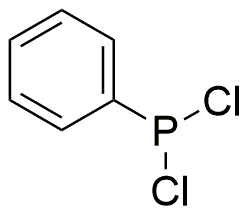Dichlorophenylphosphine is widely utilized in research focused on:
- Synthesis of Organophosphorus Compounds: It serves as a key intermediate in the production of various organophosphorus compounds, which are important in agricultural chemicals and pharmaceuticals.
- Ligand in Coordination Chemistry: This compound acts as a versatile ligand in coordination chemistry, facilitating the formation of metal complexes used in catalysis and material science.
- Pharmaceutical Development: Its reactivity allows for the modification of drug molecules, enhancing their efficacy and bioavailability in medicinal chemistry.
- Research in Chemical Sensors: Dichlorophenylphosphine is employed in the development of chemical sensors, aiding in the detection of specific analytes in environmental monitoring.
- Polymer Chemistry: It is utilized in the synthesis of phosphine-containing polymers, which exhibit unique properties beneficial for applications in electronics and coatings.
General Information
Properties
Safety and Regulations
Applications
Dichlorophenylphosphine is widely utilized in research focused on:
- Synthesis of Organophosphorus Compounds: It serves as a key intermediate in the production of various organophosphorus compounds, which are important in agricultural chemicals and pharmaceuticals.
- Ligand in Coordination Chemistry: This compound acts as a versatile ligand in coordination chemistry, facilitating the formation of metal complexes used in catalysis and material science.
- Pharmaceutical Development: Its reactivity allows for the modification of drug molecules, enhancing their efficacy and bioavailability in medicinal chemistry.
- Research in Chemical Sensors: Dichlorophenylphosphine is employed in the development of chemical sensors, aiding in the detection of specific analytes in environmental monitoring.
- Polymer Chemistry: It is utilized in the synthesis of phosphine-containing polymers, which exhibit unique properties beneficial for applications in electronics and coatings.
Documents
Safety Data Sheets (SDS)
The SDS provides comprehensive safety information on handling, storage, and disposal of the product.
Product Specification (PS)
The PS provides a comprehensive breakdown of the product’s properties, including chemical composition, physical state, purity, and storage requirements. It also details acceptable quality ranges and the product's intended applications.
Certificates of Analysis (COA)
Search for Certificates of Analysis (COA) by entering the products Lot Number. Lot and Batch Numbers can be found on a product’s label following the words ‘Lot’ or ‘Batch’.
*Catalog Number
*Lot Number
Certificates Of Origin (COO)
This COO confirms the country where the product was manufactured, and also details the materials and components used in it and whether it is derived from natural, synthetic, or other specific sources. This certificate may be required for customs, trade, and regulatory compliance.
*Catalog Number
*Lot Number
Safety Data Sheets (SDS)
The SDS provides comprehensive safety information on handling, storage, and disposal of the product.
DownloadProduct Specification (PS)
The PS provides a comprehensive breakdown of the product’s properties, including chemical composition, physical state, purity, and storage requirements. It also details acceptable quality ranges and the product's intended applications.
DownloadCertificates of Analysis (COA)
Search for Certificates of Analysis (COA) by entering the products Lot Number. Lot and Batch Numbers can be found on a product’s label following the words ‘Lot’ or ‘Batch’.
*Catalog Number
*Lot Number
Certificates Of Origin (COO)
This COO confirms the country where the product was manufactured, and also details the materials and components used in it and whether it is derived from natural, synthetic, or other specific sources. This certificate may be required for customs, trade, and regulatory compliance.


